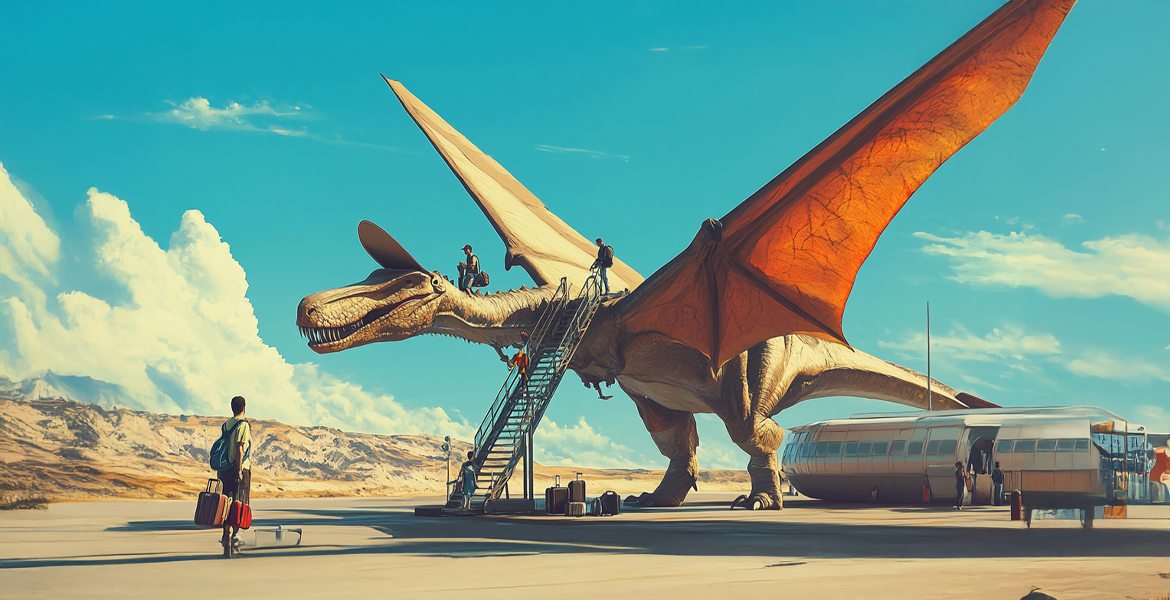Tech debt in the travel industry: Why airlines are still trying to fly with fossils
Welcome to the airline industry’s secret shame: Tech Debt. Decades of patchwork systems, outdated booking platforms, and clunky old databases that might as well be fossilized – if these systems were any older, archaeologists would be studying them. Airlines have essentially been strapping roller skates to dinosaurs while the rest of the tech world moved on to self-driving cars. The result? A digital disaster zone that just can’t keep up.
How big is the mess?
Picture this: you’re a traveller, booking a flight. The airline’s website looks like it hasn’t been updated since the 90s (except to infuriate you more), and you half-expect a dial-up tone. When you get to the airport it is no better. Massive lines and people screaming at the check in machines. That’s the reality behind the travel industry’s massive tech debt. And it’s not just annoying; it’s expensive. We’re talking $2.41 trillion per year in the US alone, just keeping this rickety digital infrastructure afloat. Travel and airline contribution to this massive number is not insignificant.
Just ask Delta, whose data centre in Atlanta failed so epically in 2016 that over 2,000 flights were grounded. Why? Their fire suppression plan was a game of “hope nothing ever catches fire,” and the system’s redundancy plan was “we’re still thinking about it.” Or Southwest’s 2022 scheduling fiasco – a system so outdated it couldn’t even keep track of where its own crew was during a winter storm, grounding tens of thousands of flights.
What is tech debt, really?
Think of tech debt as a loan you take out with the promise, “I’ll pay this back…someday.” Except someday never comes. Instead of spending the money to build solid, adaptable systems, airlines opted for shortcuts. The result? An IT infrastructure held together with rubber bands and a few crossed fingers. Each time something goes wrong, another band-aid gets slapped on. Eventually, you have a system so fragile that even a sneeze could cause an outage.
And what are the causes?

But the real causes are foundered in the thinking and the cost structures.
Legacy thinking: A habit airlines won’t kick
The travel industry operates like a pack of hobbits: not fond of adventure or change. These systems are old enough to rent a car, yet airlines cling to them as if they’re treasured family heirlooms. The mentality has been: “If it isn’t catastrophically broken, why touch it?” But now it is catastrophically broken. Airlines spent decades stitching together systems that were ancient even back when “Titanic” first hit theaters. At some point, a legacy system stops being “legacy” and starts being “liability.”
The real cost: Flying fossils and furious flyers
Operational mayhem
Technical debt isn’t just a cost on the books; it’s the source of endless, avoidable chaos. System failures, broken booking engines, and scheduling meltdowns are just par for the course. You know it’s bad when “Is it the weather or tech debt?” becomes the standard question after every delay.
Financial sinkholes
While we’re here waiting for another “system outage” announcement, airlines are hemorrhaging billions. Every breakdown means lost revenue, hefty repair costs, and compensation to stranded passengers. But fixing these messes? That costs even more. It’s like bailing water from a leaky boat and calling it an upgrade.
Customer rage
No one likes being stuck at the airport, but tech debt turns every delay into a circus. Your delay isn’t just a small glitch – it’s the industry’s skeletons falling out of the closet. Customers are fed up, and every time an airline’s website crashes, so does its credibility.
Brand shame
At this point, “airline tech outage” has its own news category. Airlines are gambling their reputations on systems that were designed back when flip phones were high-tech. Each meltdown is a reminder to customers that the airline is flying a little too close to the Stone Age.

The Future: Move over, dinosaurs—It’s time for AI and OOSD
So, what’s next? At this point, airlines need to stop trying to revive the fossils and start thinking future-forward. New tech like AI and Offer/Order/Service/Settle/Deliver (OOSSD) frameworks can finally drag these systems out of the prehistoric age and into the present. Imagine systems that can predict and prevent problems before they happen! But here’s the catch: this leap requires ditching the beloved old tech (yes, the one that everyone hates but can’t quit).
With AI, airlines could actually manage real-time disruptions instead of issuing blanket “sorry for the inconvenience” announcements. And OOSSD offers a roadmap to modernize, streamline, and get things working in sync. But, of course, this means stepping out of the past, which has never been the industry’s strong suit.
Bottom line: Adapt or go extinct
The airline industry has a choice: evolve or become a fossil itself. There’s a whole new world of tech out there, waiting to save airlines from their own outdated ways. But if they don’t act, they’ll be left in the dust. Faster dinosaurs are still dinosaurs, and it’s time for this industry to pick up the pace – or risk ending up in the Museum of Technological Mistakes.
Wouldn’t it be nice to finally board a plane without the fear of a “system outage”? It’s a long flight ahead, but the upgrade is worth it.
Well, I am not going to take it anymore. Let’s break out of this hidden fantasy land and start attacking the problem. Are you with me?

